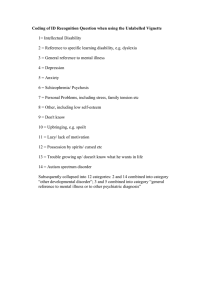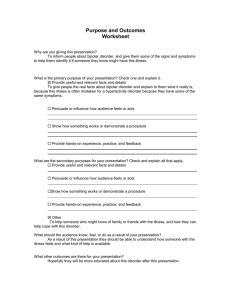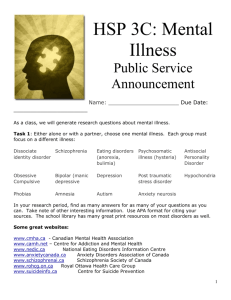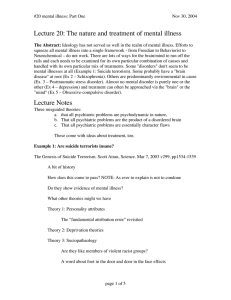Mental healthPromotion Mental Health:“Without
advertisement
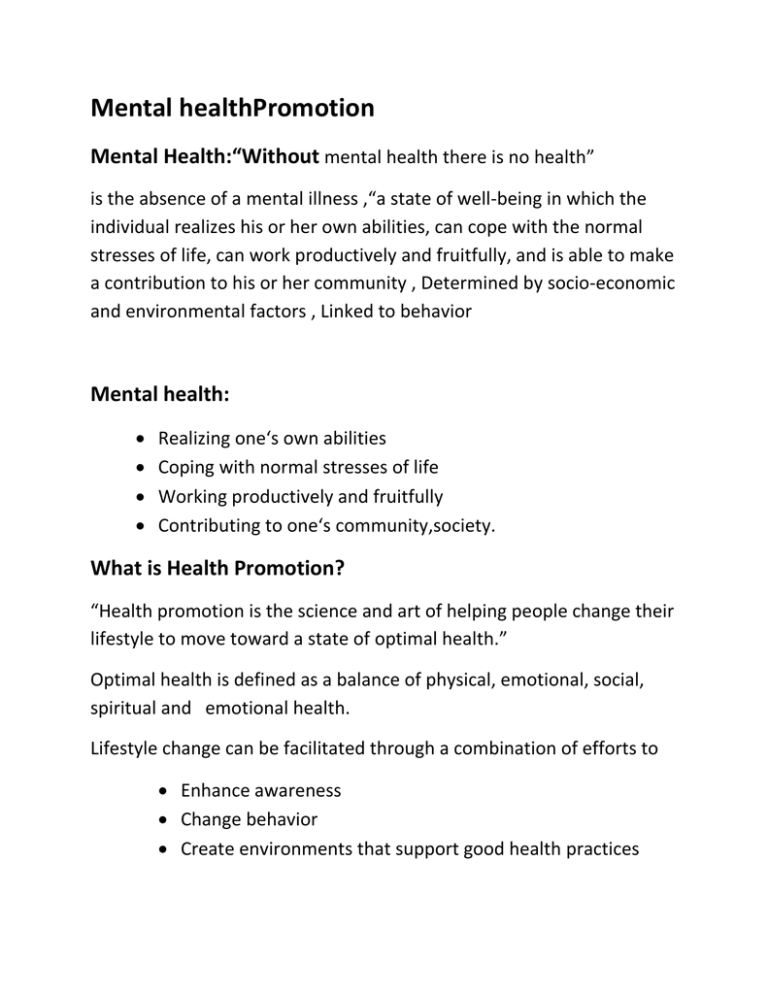
Mental healthPromotion Mental Health:“Without mental health there is no health” is the absence of a mental illness ,“a state of well-being in which the individual realizes his or her own abilities, can cope with the normal stresses of life, can work productively and fruitfully, and is able to make a contribution to his or her community , Determined by socio-economic and environmental factors , Linked to behavior Mental health: Realizing one‘s own abilities Coping with normal stresses of life Working productively and fruitfully Contributing to one‘s community,society. What is Health Promotion? “Health promotion is the science and art of helping people change their lifestyle to move toward a state of optimal health.” Optimal health is defined as a balance of physical, emotional, social, spiritual and emotional health. Lifestyle change can be facilitated through a combination of efforts to Enhance awareness Change behavior Create environments that support good health practices Of these, supportive environments will probably have the greatest impact in producing lasting change. –… health promotion demands coordinated action by all concerned: governments, health, social & economic sectors, local authorities, industry, media The prerequisites and prospects for health cannot be ensured by the health sector alone Health Promotion Activities: Health education programs - to raise awareness of health risk and to encourage behavior change Primary health education - to prevent ill health developing (e.g. diet, hygiene, social skills, etc.) Preventive health services - e.g. family planning, immunization and well person clinics Community-based work - local communities identify health problems and address them Healthy public policies - housing, employment, transport, etc. Health promotion action means: Build healthy public policy Create supportive environments Strengthen community actions Develop personal skills Reorient health services Mental Health Promotion: “... The process of enhancing the capacity of individuals and communities to take control over their lives and improve their mental health. Mental Health Promotion uses strategies that foster supportive environments and individual resilience, while showing respect for culture, equity, social justice, interconnections and personal dignity.” Mental health promotion works by Strengthening individuals (micro level): increasing resilience, promotion of self-esteem, life and coping skills, parenting skillsStrengthening communities increasing social inclusion, improving neighborhood environments, service development, in settings Reducing structural barriers to mental health by reducing discrimination & inequalities, access to education, meaningful employment, housing, support for vulnerable people Mental health promotioncan: Improved physical health Better educational performance of children Better productivity of workers in business/industry Improved relationships within families and broader community Lower rates of some mental disorders Prevention and Mental Health Promotion: Prevention and mental health promotion are important parts of psychiatric care. The mereabsence of mental illness does not mean thatone has positive mental health or a high qualityof life. Prevention model the "patient" is community rather than the individual, and the focus is on the amount ofmental health or illness in the community as a whole, including factors that promote or inhibitmental health. Levels of Prevention: Primary prevention: true preventionbefore illness starts: aims at reducing the occurrence of new cases of the disorder.is lowering the incidence of a mental disorder by reducing the rate at which new cases of a disorder develop Secondary prevention: directed at diagnosis and intervention of those who are experiencing health problems or illnesses: aims at reducing the duration of the disorder through effective early intervention It involves decreasing the prevalence of a mental disorder by reducing the number of existing cases through early case finding, screening, and prompt, effective treatment. Tertiary prevention: containing or slowing down the damage: directed at rehabilitation of those clients with permanent and irreversible disease or disability prevents the long-term complications of the disease.attempts to reduce the severity of a mental disorder and its associated disability through rehabilitative activities. Examples of Level of Prevention: Primary Prevention – immunizations, class for new parents, on safetyteaching, older adults the value of exercise. Secondary Prevention – vision screening, breast and testicular exams. Tertiary Prevention – cardiac rehabilitation, nutrition classes for new diabetics. Models of Primary Prevention: Primary prevention activities in psychiatriccare have two basic aims: 1. To help people avoid stressors or cope withthem more adaptively. 2. To change the resources, policies, or agents ofthe environment so that they no longer causestress but rather enhance people's functioning. Nursing Prevention Model: 1. The nursing prevention model stresses theimportance of promoting mental health andpreventing mental illness by focusing on riskfactors, protective factors, vulnerability, andhuman responses. 2. In the nursing prevention model, the"patient" may be and individual, family, or Community Dr, Saja Hashem Prof. Psychiatric Nursing
